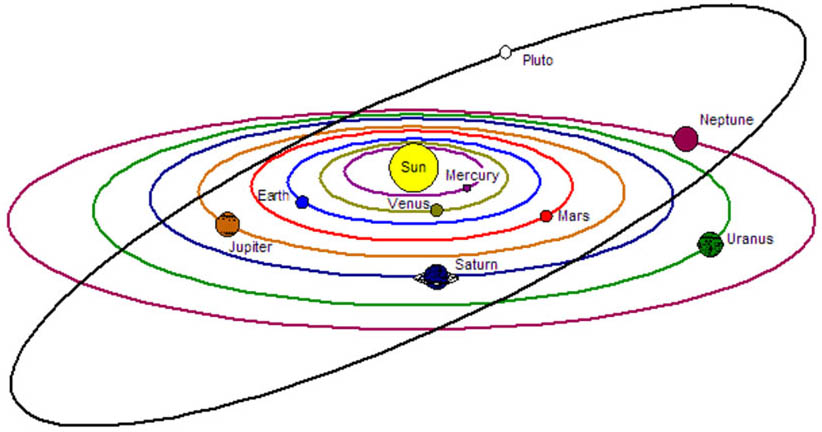 Long before the invention of the telescope, our ancestors observed the nightly motions of the Two Lights and Five Wanderers: the Sun, Moon, Mercury, Venus, Mars, Jupiter and Saturn. They extrapolated from this fundamental pattern, a Universe of correspondences. Our Solar System, they suggested, exists within us as well as outside us.
Long before the invention of the telescope, our ancestors observed the nightly motions of the Two Lights and Five Wanderers: the Sun, Moon, Mercury, Venus, Mars, Jupiter and Saturn. They extrapolated from this fundamental pattern, a Universe of correspondences. Our Solar System, they suggested, exists within us as well as outside us.
Our days of the week are named after these seven "Gods" of the ancients: Monday for the Moon, Sunday for the Sun, Friday for Freya (Venus), etc. The Greeks postulated a universe of Five Elements or essences: Earth, Water, Fire, Air and Kosmos, the Fifth Essence, or "Quintessence". Earth relates to the Solid state. Water relates to the Liquid state. Air relates to the Gaseous state.
Kosmos is the space in which these three elements exist. Fire is the energy which drives the transformation of Earth, Water and Air into one another - much as the process of digestion transforms the materials within the body. The Five Elements relate not only to the world outside our skin (the Solar System), but to design principles at work inside our bodies and even within our psyche - the Solar System Within.
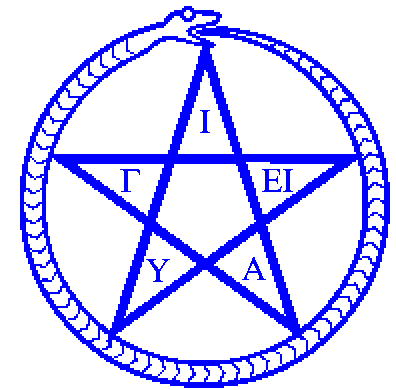 The ancient Pythagoreans denoted the five elements via the symbols H Y G E A - from which we get our English word hygiene. The Pentagram was considered sacred to their Goddess Hygeia, patroness of health, cleanliness and sanitation. She was the daughter of Aesclepius, their God of Medicine and Healing. The 5-pointed star appears on many flags and in many important places.
The ancient Pythagoreans denoted the five elements via the symbols H Y G E A - from which we get our English word hygiene. The Pentagram was considered sacred to their Goddess Hygeia, patroness of health, cleanliness and sanitation. She was the daughter of Aesclepius, their God of Medicine and Healing. The 5-pointed star appears on many flags and in many important places.
 Traditional Chinese Medicine is also modeled after the Elements and the visible planets: Yang, Yin and Wu Xing or Five Phases: Earth, Water, Fire, Metal and Wood. As in the Greek and Indian systems, these phases or elements correspond to the heavenly bodies. The Chinese names for the planets are, to this day, Earth Star (Saturn), Wood Star (Jupiter), Fire Star (Mars) and so on.
Traditional Chinese Medicine is also modeled after the Elements and the visible planets: Yang, Yin and Wu Xing or Five Phases: Earth, Water, Fire, Metal and Wood. As in the Greek and Indian systems, these phases or elements correspond to the heavenly bodies. The Chinese names for the planets are, to this day, Earth Star (Saturn), Wood Star (Jupiter), Fire Star (Mars) and so on.
Only a passing distinction is made, in these traditional systems, between body and mind, Inner and Outer. That which exists outside, exists inside. Each is a reflection of the other.
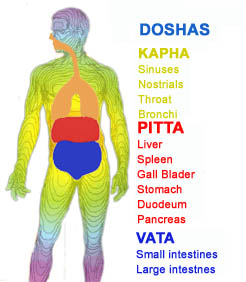 The ancient Hindus used the same basic system of Elements. Ayurveda, the traditional Indian system of healing, is nothing more than the Pancha Maha Tattwas (Five Great Elements) applied to Medicine. Ayurveda deals with 3 metabolic forces, called Doshas ("those which go wrong").
The ancient Hindus used the same basic system of Elements. Ayurveda, the traditional Indian system of healing, is nothing more than the Pancha Maha Tattwas (Five Great Elements) applied to Medicine. Ayurveda deals with 3 metabolic forces, called Doshas ("those which go wrong").
The Three Doshas are the same Five Elements, combined as they function within the body. Kapha ("that which sticks") is Earth and Water. Pitta ("that which burns") is Water and Fire. Vata ("that which blows") is Air and Akasha or space.
According to Ayurveda, disease is present when there is an imbalance of the Three Doshas. Health is harmony of the Doshas.
 In Kriya Yoga, the five planets correspond to the five chakras below the head. They are arranged in the same order as they appear in the Solar System: Mercury in the throat, Venus at the Heart, Mars in the abdomen. Jupiter is in the lower abdomen and Saturn at the base of the spine. Adding the Two Lights - the Sun in the forehead and Moon at the rear of the head - the ancients had a complete visible Solar System.
In Kriya Yoga, the five planets correspond to the five chakras below the head. They are arranged in the same order as they appear in the Solar System: Mercury in the throat, Venus at the Heart, Mars in the abdomen. Jupiter is in the lower abdomen and Saturn at the base of the spine. Adding the Two Lights - the Sun in the forehead and Moon at the rear of the head - the ancients had a complete visible Solar System.
If we limit ourselves to the five planets (and not the Sun and Moon) the middle chakra is the third one: Mars, the "Fire Star" in Chinese. Fire is the principle which transforms the other elements into one another: solids, liquids and gases. It is the principle of Metabolism. It runs the body. The physical world runs on Fire. The body is active during the day time, when the Sun is shining. The Sun is exalted in Aries, the Cardinal Fire sign ruled by Mars. Fire promotes vitality and governs the world of athletics, ambition and worldly success - which are the traditional concerns of Men.
In the Vedic rites, Fire is the primary symbol of Divinity. He is Agni, the being who conveys the ritual offerings to the Gods. The first prayer in the Rig Veda, one of the most ancient religious texts, is to Agni. The first word in the Veda, is Agni:
agním īḷe puróhitaṃ yajñásya devám ṛtvíjam
hótāraṃ ratnadhâtamam
I praise Agni, the high priest,
The shining one, minister of sacrifices,
The invoker, the bestower of wealth !
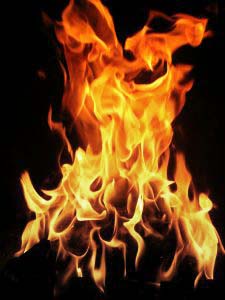 From Agni, we get our English words "ignition" and "igneous" - and the names Ignatius, Ignacio, etc. In the body, Fire is the digestive process, which takes the products of nutrition to the mind and organs. The manifest world is experienced when the pranas move predominantly through Pingala Nadi, the Solar Channel which moves towards the right. In the mind, Fire manifests as Tejas ("luster") - our ability to grasp and digest concepts and experience. Fire governs the retina in the eye, pigmentation in the skin.
From Agni, we get our English words "ignition" and "igneous" - and the names Ignatius, Ignacio, etc. In the body, Fire is the digestive process, which takes the products of nutrition to the mind and organs. The manifest world is experienced when the pranas move predominantly through Pingala Nadi, the Solar Channel which moves towards the right. In the mind, Fire manifests as Tejas ("luster") - our ability to grasp and digest concepts and experience. Fire governs the retina in the eye, pigmentation in the skin.
When too much Fire appears in the chart, the native can suffer from fevers, inflammation, accidents and problems relating to the blood and liver. The personality can be overly enthusiastic, aggressive and impatient and one can have problems with anger management. When Fire is deficient, individuals lack warmth and muscular strength. They have a slow metabolism and suffer from problems of congestion and stagnation. They lack motivation and clearly defined goals. They are prone to depression and victimization by others.
When balanced, Fire brings the basic zest for of life. It is Ra, the Creator God of the Egyptians. It is Kudanlini Shakti. It is the seven-headed Dragon which gets tamed by the hero. The evolution of the soul, is the balancing of Fire. As the planets move through the Solar System, the energies move through the chakras. It is the principle of Fire which purifies the soul and brings ultimate illumination.
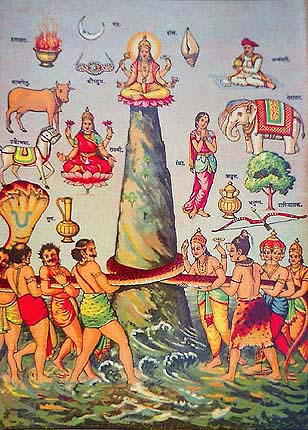 Once upon a Yogi time, a sage named Durvasa gave a flower garland to Indra, the king of the Devas ("the shining ones", angels). Indra gave the garland to his elephant and the elephant trampled it. Deeply insulted, sage Durvasa cursed the Devas and took away their immortality and divine status.
Once upon a Yogi time, a sage named Durvasa gave a flower garland to Indra, the king of the Devas ("the shining ones", angels). Indra gave the garland to his elephant and the elephant trampled it. Deeply insulted, sage Durvasa cursed the Devas and took away their immortality and divine status.
In desperation, the Devas turned to Lord Vishnu ("the pervader") for help. Vishnu told them that the only way to regain their lost glory was to drink the Nectar of Immortality, which was hidden at the bottom of the Ocean of Milk. After declaring a truce with their foes the Asuras ("the powerful ones"), Indra and his Devas - together with the Asuras - churned the Ocean of Milk, using the giant serpent Vasuki as a churning rope and Mount Mandara as the churning staff.
When they began churning, the mountain began sinking into the ocean. Taking the form of a turtle Kurma, Vishnu bore the entire weight of the mountain. The churning continued and various objects were thrown out including the deadly poison Halahala, whose fumes threatened to destroy the Devas and the Asuras. Lord Shiva came to their rescue: he gathered all the poison in his palms and drank it. His consort Parvathi clasped his throat and the poison remained there. Hence Lord Shiva became known as Neelakanta ("the blue-throated one").
 According to the story, “fourteen precious things” came out of the ocean, culminating with Dhanvantari, the physician of the gods. He emerged from the depths, holding a pot containing the Nectar of Immortality. The Asuras immediately rushed in and grabbed the nectar, while quarreling among themselves.
According to the story, “fourteen precious things” came out of the ocean, culminating with Dhanvantari, the physician of the gods. He emerged from the depths, holding a pot containing the Nectar of Immortality. The Asuras immediately rushed in and grabbed the nectar, while quarreling among themselves.
Lord Vishnu again came to the rescue, taking the form of a beautiful damsel named Mohini ("the entrancing one"). He distracted the Asuras, retrieved the potion and then distributed it to the Devas. Though the Asuras realized Vishnu’s tricks, it was too late, as the Devas had already regained their immortality.
While Vishnu was handing out the potion to the assembled Gods, a demon named Rahu sat down between the Sun and the Moon. He managed to take a drink of the amrita ("no death") and thus became immortal too. Vishnu, alert to the ruse, severed Rahu's head with his divine discus called Sudarshan ("the best view"). This is the mythical origin of Rahu and Ketu, the North and South Nodes of the Moon.
According to the tale, the Nodes extract periodic revenge on the Sun and Moon, because it is near the Nodes where eclipses occur. The Sudarshan Chakra is a horoscope technique where we use 3 charts at the same time: from the perspective of the Ascendant, the Moon and the Sun. Hence the name "best view", which suggests that under such scrutiny, the horoscope can best be judged.
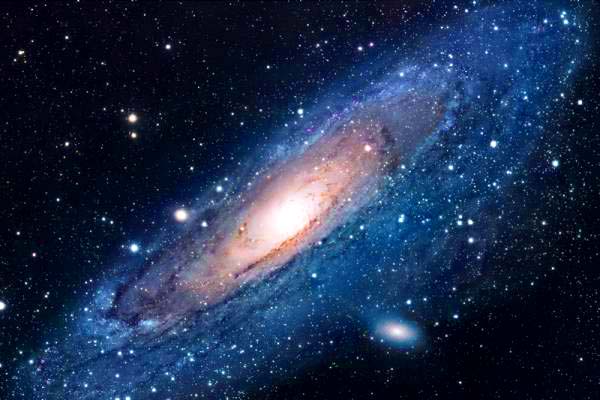 This story appears in three different Indian texts and shows the integration of Yoga and Astrology. The Ocean of Milk is the Psyche. The great central mountain is the spinal cord. The two ends of the serpent are the lunar and solar channels, Ida and Pingala. The demons and angels who tug on them, represent the masculine and feminine forces within us all.
This story appears in three different Indian texts and shows the integration of Yoga and Astrology. The Ocean of Milk is the Psyche. The great central mountain is the spinal cord. The two ends of the serpent are the lunar and solar channels, Ida and Pingala. The demons and angels who tug on them, represent the masculine and feminine forces within us all.
The churning of the ocean is the process of evolution, by Karma or experience. Life consists of alternating pleasant and unpleasant events, day and night, winter and summer. These cycles of duality recur until the individual soul learns to rise above them and identify with an awareness which transcends the dvandvas, the pairs of opposites.
The ocean represents the vast Universe, which appears milky due to the light of the stars. The Asuras and Devas represent the malefic and benefic planets, which circle the astrological chart, symbolized by the great central mountain. The continual intermingling of astrological forces is the churning, which brings the experiences of life that ripen the soul. The nectar of immortality is the enlightened state of the mystic, who realizes the Self, which was never born and never dies.
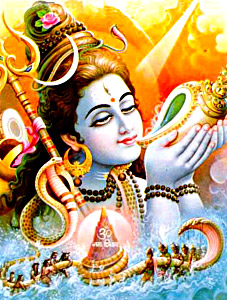 Just as churning brought up all kinds of impurities and noxious substances, the journey of the soul is not without trials and troubles. From a religious perspective, the story suggests that Divine Grace comes to the rescue at critical times, swallowing the "poisons" which emerge along the way.
Just as churning brought up all kinds of impurities and noxious substances, the journey of the soul is not without trials and troubles. From a religious perspective, the story suggests that Divine Grace comes to the rescue at critical times, swallowing the "poisons" which emerge along the way.
From a psychological perspective, we move up the ladder of evolution as our subconscious emotional imbalances are brought out into the light of day, where they can be discerned, understood and corrected. Hindu mystics refer to these trials, as Karmic Lessons. Others might look upon them, as stepping stones towards attainment of Insight.
Lord Shiva the Transformer, represents that aspect of consciousness which is able to drink the "poisons" - the imbalanced forces within - and purify them, making them symbolically blue. The blue-throated one symbolizes the balanced energies of Mercury (Virgo/Gemini), at the level of the Vishudha Chakra in the throat. Vishudha means "very pure" and symbolizes the spiritually mature intellect.
Lord Vishnu the Sustainer represents balanced Consciousness, which promotes the process of Self Realization. By directing the Devas and Asuras to work together, he reveals that the path of balance leads to the discovery of our immortality - which has been there all along. It has been merely overlooked, obscured within the depths of the psyche.
The Churning of the Ocean is an allegorical symbol of Yoga, a process by which we harmonize the forces within, to restore our own wellness and discover our inherent divinity.
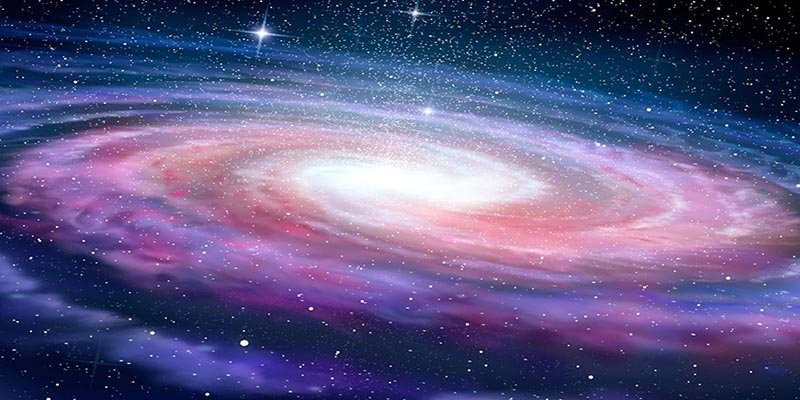 Want to learn more about Astrology ?
Want to learn more about Astrology ?
See these authors: